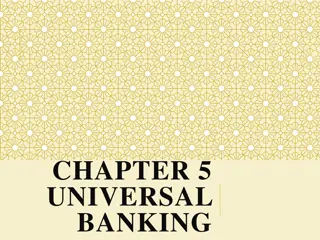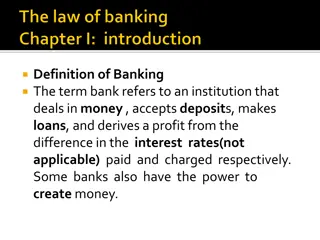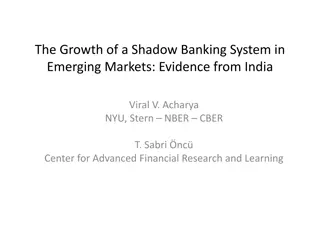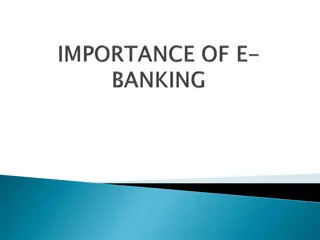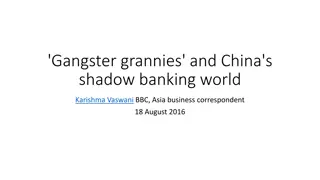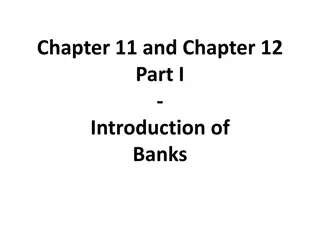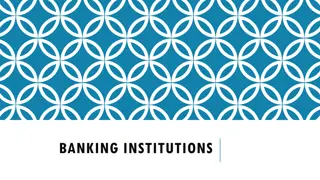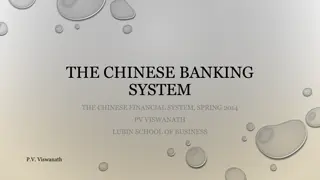Evolution of Banking: From Benches to Modern Institutions
Exploring the historical evolution of banking, from early transactions on benches in marketplaces to the development of banking systems in ancient civilizations like Babylon and Greece. The journey continues through the impact of religious beliefs on banking practices, the influence of English Banking Law on Indian banking regulations, and the establishment of banking customs and laws during the post-industrial revolution period. The narrative culminates with the role of goldsmiths in early banking practices and the transition to modern banking institutions.
Download Presentation

Please find below an Image/Link to download the presentation.
The content on the website is provided AS IS for your information and personal use only. It may not be sold, licensed, or shared on other websites without obtaining consent from the author.If you encounter any issues during the download, it is possible that the publisher has removed the file from their server.
You are allowed to download the files provided on this website for personal or commercial use, subject to the condition that they are used lawfully. All files are the property of their respective owners.
The content on the website is provided AS IS for your information and personal use only. It may not be sold, licensed, or shared on other websites without obtaining consent from the author.
E N D
Presentation Transcript
bancus or banque which means bench. Early bankers, the Jews transacted their business on benches in the market place.
When banker was unable to meet his obligation, his bench was broken up by people; it is called bankrupt. The word bank is originally derived from the German word back meaning joint stock fund.
2000 B.C., the Babiloninas had developed a banking system. Temples of Babylon were used as banks. Great temples Ephesus & of Delphi were the most powerful of the Greek banking institution .
Spread of irreligion destroyed the public sense of security in depositing valuables in temple & priest were no where acting as financial agents. Aristotle s dictum-charging of interest was unnatural and consequently immoral. Even now Mohammedans in obedience to the commands contained in their religious books, refuse to accept interest on money loans.
The India banking law is based to a very large extent upon the English Banking Law. Beside Banking Law, the Law of Contract, the Law of Torts and other branches of commercial and civil laws are applicable to banks as to others.
Law merchant or customs of merchants ratified by courts and become part of general law. Law merchant or Lex Lex mercatoria mercatoria Lord Mansfield s ruling Post industrial revolution period, banking law largely judge made law. Took into consideration customs of merchants of the advanced European Countries. Lord Mansfield s ruling
Royal exchanger In England, Edward III-Royal Exchanger for the benefit of the Crown. Goldsmiths Land ceased to be the only form of wealth, merchants began to hold part of their capital in cash. Merchants entrusted their cashiers with large sums, later misappropriated. Royal exchanger Goldsmiths
City merchants decided to keep their cash with goldsmiths, who had strong rooms and doors and employed watchmen. Early beginning of Issue and Deposit banking Large sums of money were left with the goldsmiths for safe custody, against signed receipts- goldsmiths notes . Notes- embodying an undertaking to return money to depositor or to bearer on demand. Early beginning of Issue and Deposit banking
Transformed from receipt to a bank note- considerable circulation. Large money were left with them. Following Dutch bankers-thought it is profitable to lend which is to be repaid within a fixed time. In order to attract more depositors they began to offer interest on deposits. Current banking In 1672, English banking received a rude setback. Current banking
Charles II borrowed heavily and repudiated his debts. Crisis ensued, leading to general suspension of payments. Confidence, however, was restored. Receive deposits on current account i.e., money withdrawal without notice. Bank of England (1694) The Tonnage Act Financial difficulties of William III, was carrying war with France. The public distrust of goldsmiths. Bank of England (1694)
Mr. Patterson-raise $1,200,000, a loan to the Govt, certain concession the right to issue notes were given to proposed institution. Certain important provisions of the Act are as follows- 1. Authorized the raising of $1,200,00 by subscription, the subscribers forming a corporation called The Governor and company of the Bank of England
2.The Corporation was to lend the whole of its capital to the Govt , interest @ 8% & $4000 for expenses of management. 3. Corp. have a privilege of bank for12 years, Govt preserved the right of annulling the charter after giving 1 yr notice toCorp. 4. Corp. was forbidden to trade in any merchandise, but allowed to deal in bill of exchange, gold or silver bullion & to sell wares or merchandise upon which it has advanced money.
The new bank is a big competitor to the comparatively small private banks. Monopoly of note issue bank, with more than 6 partners, issuing promissory notes i.e., bank notes Limited supply of Bank of England notes The Act gave monopoly of note issue to the Bank of England, so far joint stock companies were concerned, but left private banks having not more than six partners free to issue notes. Monopoly of note issue: prohibited any other Limited supply of Bank of England notes
Notes of pvt banks did not circulate to any appreciable extent unprofitable and gave it up; began to develop deposit banking. They received deposits which were at first withdrawable by letter, and later by cheques. Printed cheque forms were first issued between 1749 & 1759. Bank of England notes were not popular beyond the metropolis, as it did not have any outside branch. Pvt banks in provincial cities began to play an important role after the middle of 18thcentury.
Restriction on monopoly It was realized that joint stock banks with right of issue should be started outside London. In 1826 an Act was passed which allowed banks to be started with unlimited liability, consisting more than 6 partners , with the right to issue notes, provided they have no office within a radius of 65 miles from London, it was removed Mr. Joplin-no such monopoly was intended. Restriction on monopoly
Peels Act, 1844 Peel s Act, 1844 No limit to the amount of notes, which pvt bankers and after 1826 the country joint- stock banks were allowed to issue. resulted in numerous banking crisis and bank failures . Extinction of the right of issue of bank notes and deposit banking came into place.
Growth of deposit banking and currency Currency and Bank Notes Act, 1928- Bank of England was given exclusive right to issue notes. In 1947 it was nationalized. Growth of deposit banking and cheque currency cheque History of Banking in India India was not a stranger to the concept of Banking. History of Banking in India
Provisions of banking were found in Kautilya s Arthashastra- Sahukars and Mahajans Manusmriti etc Hundi hund , means to collect. The bills of exchange are generally used for the collection of debts. Hundi
For instance, when a merchant in Bombay sells goods to a merchant in Delhi, the former draws a bills of exchange on the latter, so to collect the price of those goods. llly when a merchant in Calcutta desires to collect a debt, due to merchants in Madras, the former may draw a Hundi for the amount upon the latter.
Types of Darshani hundi payable at sight Muddati hundi payable after specified period of time. Shah Jog Hundi payable by drawee only to a respectable person. Nature of document a promissory note or a hundi unconditional undertaking that the defendants has promised to pay an amount to petitioner. Types of Hundis Hundis - -3 types 3 types Nature of document a promissory note or a hundi
Mere inscription of word Hundi above the stamp is not sufficient to hold the document as Shah Jog Hundi Usury Usury, or high rate of interest, was widely prevalent in India. In Bengal, money was frequently lent to farmers at 40% or 60% per annum, while the standing crop was mortgaged for repayment of the loan. Usury- - The Usurious Loans Act, 1918 The Usurious Loans Act, 1918
Most writers attribute usury to the state of insecurity in India risk-low financial status of the borrowers. Money lender rather than a banker. State Money The money lenders in India are regulated under the respective State Money-Lenders Acts e.g., the Kerala Money Lenders Act, 1958, the Karnataka Money Lenders Act, 1961etc State Money- -Lenders Acts Lenders Acts
Money- Lending legislations of various states have similar salient provisions - Requirement of Registration/license Duty of money lenders with respect to maintaining and providing statement of accounts to the debtors. Penalty for carrying on business without license Intimidating the debtors or interfering with their day to day activities Maximum rate of interests
The Constitution of India has conferred power to legislate on matters relating to money lending to the states. RBI working group/Radhakrishna Expert Group on Agricultural indebtedness (2008) recommended there should be stricter and more transparent regulation of Money- Lenders.
Pvt. firms or individuals Business was hereditary and confined to few castes & communities like vaishyas, Jains, Marwaries and Chettis. Financial intermediaries Indigenous bankers v. money lenders Deal in short term credit instrument like hundis and commercial bill. They provided credit to traders, agriculturist, small producers and Govt also. Lending on basis of promissory note.
Simple method of accounting. Easily accessible. Do not have fix banking hours. No much formalities and procedures. Defects in Indigenous banking Hindrance in the development of an organized money market. High rate of interest Involved other business. Manipulating accounts Secrecy of accounts, neither audited nor published. Commission agents Defects in Indigenous banking
Deducting interest in advance-undeseriable practice. Give loans for any purpose. Suggestions: Indian Central Banking Enquiry Committee,1931 The Banking Commission, 1971 Only banking business and not any other activity. Maintain account books in a prescribed and recognized form and get them audited. Linked with commercial banks. Suggestions:
Benefit of Bankers Book Evidence Act shpuld be extended to them. Their banking practices need to be upgraded. These banks are encouraged to become corporate bodies rather than continuing as family based enterprises.
profit-based financial institution. Primary functions Fixed or time deposit Saving Deposit Accepting deposits Current Deposit Recurring Deposit
Loans Loans and advances Cash Credit Overdraft Purchasing and discounting of bills
Secondary Functions Secondary Functions Agency Functions Utility Functions Transfer of funds/ Locker facility remittance Payment of bills Foreign exchange Underwriter Provide market info Collection of cheque Advice to exporters Collecting money on Behalf of customers Income tax returns Trustee, administrator Agency Functions Utility Functions
Set up in July 1964, as a wholly-owned subsidiary of RBI. Autonomy in 1976. Apex institution in the arena of development banking. Major role is to coordinate the activities of other development banks. Provides medium & long term finance to business units.
Functions: Planning, promoting & developing industries- fill gaps in the industrial structure by conceiving, preparing & floating new projects. Technical & administrative assistance for promotion, management & expansion of industry. Providing refinance to the IFCI and other financial institutions. Purchasing or underwriting shares and debentures of industrial concerns. Functions:
Guaranteeing deferred payments due from industrial concerns. Undertaking market and investment research, surveys and techno-economic studies. Entrepreneurship development programme.
Leader Coordinator Innovator, promotional
The scope of business of the IDBI extended- direct industrial assistance by way of project loans, equipment finance scheme. Assistance to service sector industries like health care, informatics. Small Industries Development Bank of India (SIDBI)-1990-subsidary to IDBI delinked in 1997- apex bank in financing small scale industries.
Germany First cooperative credit society was Act (1904) Registered under respective state Cooperative Societies Act. (1959). Small financial entities. Voluntary association of members of locality or professional community. Operate in rural (finance farming, cattle) and urban areas (self employment, small scale units, personal finance). They are governed by RBI (licensing, rate of interest, area of operation), State Govt (management, merging, liquidation) Higher rate of interest on deposits. Credit oriented movement.
State Cooperative Bank District/Central Cooperative Bank Primary Credit Societies/Urban Cooperative Bank
The Maclagan committee (1915) on co- operative, recommended some important policies regarding the three-tier system of co-operative societies. The first urban co-operative society was established in India, Annyona Shakari Mandli Co-operative Bank located in Baroda (Gujarat state) on 5 Feb 1889. Economic sustainable development. Banking to doorsteps of common people.
The Objectives and Functions of the Urban Co- Operative Banks: 1. Primarily, to rise funds for lending money to its members 2. To attract deposits from members as well as non- members 3. To encourage thrift, self-help ad mutual aid among members. 4. To draw, make, accept, discount, by sell, collect and deal in bills of exchange, draft, certificates and other securities 5. To provide safe deposits vaults. 6. To issue letters of credit and traveler s cheques 7. To arrange for the safe custody of valuables 8. It acts as an agent of its customers 9. To borrow funds and utilize them for giving loans to needy persons
o Problems Many regulatory bodies. No expertise & skills. Recruitments are Politicized. Unduly dependent on refinance. No active participation of members. Problems Reforms RBI suggested: Single regulatory body. Reforms
Established on 1st April, 1935 under the RBI Act, 1934. Was established on recommendations of Hilton Young Commission. RBI nationalized in 1949 Originally a shareholders bank. Paid up capital was Rs. 5 crores. Took over the function of currency issue from GOI & power of credit control from SBI.
In 1949 Banking Companies Act was enacted and now renamed as Banking Regulation Act, 1949. Functions of RBI RBI was constituted to: 1. Regulate the issue of banknotes 2. Maintain reserves with a view to securing monetary stability. 3. Operate the credit & currency system of the country to its advantage.
1.Issuer of currency in India Sole authority to issue, control & regulate currency in India. It issues & exchanges or destroys currency & coins not fit for circulation. Objective is to give adequate quantity of supplies of currency notes & coins in good quantity. 2. Banker to the Govt Performs merchant banking functions of State & Central Govts. Also acts as banker to GOI and State Govts.
Accept money on account of the Govt, to make payment on behalf of the Govt. Carries out exchange remittance& other banking operations including Govt securities and management of public debt of the govt. 3. Baker of Commercial Banks RBI act as Banker of Banks. Maintains banking accounts of all scheduled Banks. All banks keep and maintain their accounts with RBI
4. Organizer of Commercial Banking System Concerned with the organization of a sound & healthy commercial banking system. Ensuring effective co-ordination & control over credit through appropriate monetary & credit policies followed from time to time. 5. Regulator & supervisor of Financial Sysem Prescribes broad parameters of banking operations. Objective is to i. maintain public confidence in the system ii. protect depositors interest. iii. provide cost effective banking service to the public.
6. Financial Supervision Guidance of the Board for Financial Supervision (BFS), constituted in Nov 1994 as a committee of the Central Board of Directors of the RBI. Objective of BFS: undertake consolidated supervision of financial sector comprsing commercial banks, financial institutions & non banking financial institutions. BFS through the Audit Sub-Committee aims at upgrading the quality of the statutory audit & internal audit functions in banks & FI.
BFS oversees the functioning of Department of Banking Supervision(DBS), Department of Non-Banking Supervision(DNBS) & Financial Institution Division (FID). Gives direction on the regulatory & supervisory issues. 7. Monetary Authority RBI formulates, implements & monitors the monetary policy. Objective is maintaining price stability & ensuring adequate flow of credit to productive sectors.
8. Control the volume of credit Exercise it control over volume of credit created by the commercial banks in order to ensure price stability. Quantitative Credit Control 1. Bank Rate 2. Repo Rate 3. Reverse Repo Rate 4. Open Market Operations 5. Variable Reserve Requirements 6. Selective Credit Control







